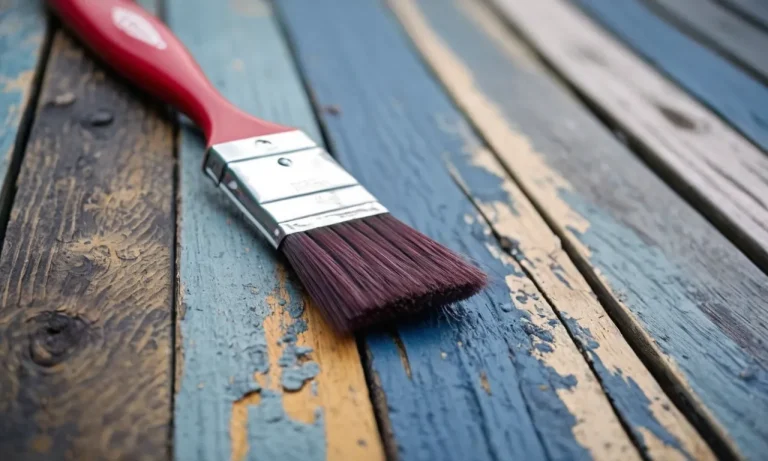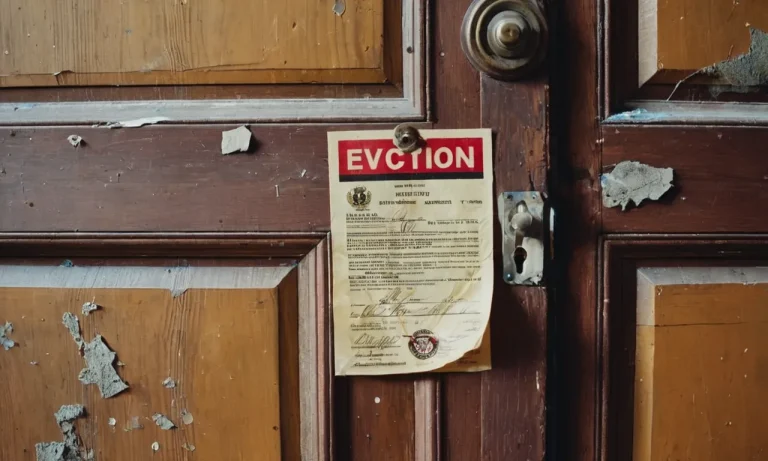How To Completely Remove Bed Bugs From Wood Furniture
Bed bugs can be extremely difficult to get rid of once they infest furniture, especially wooden furniture with cracks and crevices they can hide in. If you’ve discovered bed bugs in your wood furniture, you’ll need to take proactive and thorough measures to fully eliminate the pests.
If you’re short on time, here’s a quick answer to your question: use high heat, isolation, and pesticides to kill bed bugs and eggs. Vacuum thoroughly and seal infested furniture in plastic for at least a year.
In this comprehensive guide, we’ll walk through all the steps you should take to fully remove a bed bug infestation from wood furniture, including preparation, inspection, treatment, and prevention.
Preparing for Bed Bug Treatment
Clear Surrounding Areas
Before tackling the bed bugs in your wood furniture, it’s important to clear the surrounding areas. Remove any clutter, such as clothing, blankets, or pillows, from the vicinity of the furniture. This will make it easier to access the furniture and ensure that the treatment is effective.
Additionally, vacuum the area thoroughly to remove any loose bed bugs or eggs that may be hiding in the carpet or on nearby surfaces.
Disassemble Furniture
To effectively eliminate bed bugs from wood furniture, it is recommended to disassemble the furniture as much as possible. Take apart any removable components, such as drawers, cushions, or legs. This will expose hidden areas where bed bugs may be hiding.
Inspect each piece carefully, paying close attention to seams, cracks, and crevices where bed bugs tend to hide.
Clean Thoroughly
Once the furniture is disassembled, it’s time to clean each piece thoroughly. Start by using a stiff brush or vacuum to remove any visible bed bugs, eggs, or droppings. Next, wipe down the surfaces with a solution of warm water and mild detergent.
Pay special attention to the joints and corners where bed bugs may be hiding. After cleaning, allow the furniture to dry completely before reassembling it.
Raise Room Temperature
Bed bugs are sensitive to heat, so raising the room temperature can help in their eradication. Set the thermostat to a temperature of at least 120°F (49°C) and leave it for several hours. This heat treatment can penetrate deep into the wood and kill any bed bugs or eggs that may be hiding inside.
Keep in mind that this method may not be suitable for all types of wood furniture, so it’s important to consult a professional or manufacturer’s guidelines before attempting it.
Purchase Bed Bug Supplies
To completely remove bed bugs from wood furniture, you may need to invest in some bed bug supplies. These can include insecticides specifically designed for bed bug eradication, mattress encasements, and bed bug traps.
It’s important to choose products that are safe for use on wood furniture and follow the instructions carefully. Consider consulting with a pest control professional for guidance on the most effective products and techniques for your specific situation.
Remember, bed bug infestations can be challenging to eliminate completely, especially from wood furniture. If you’re unsure about how to proceed or if the infestation persists despite your efforts, it’s advisable to seek professional help.
They have the knowledge and experience to effectively treat and eliminate bed bugs, ensuring a bed bug-free environment in your home.
Thoroughly Inspecting Furniture
When it comes to removing bed bugs from wood furniture, a thorough inspection is the first step in the process. By carefully examining the furniture, you can identify any signs of bed bug infestation and determine the extent of the problem.
Here are some essential tips for conducting a comprehensive inspection:
Check All Joints and Crevices
Bed bugs are notorious for hiding in tiny cracks and crevices, making it crucial to inspect all joints and seams of the furniture. Use a flashlight and a magnifying glass to get a closer look at these areas.
Pay special attention to corners, edges, and any small openings where bed bugs may seek refuge.
Use a Flashlight
A flashlight is an indispensable tool for inspecting wood furniture for bed bugs. It helps to illuminate dark areas and makes it easier to spot the tiny pests. By shining the light around the furniture’s surface and interior, you can identify any live bugs, shed skins, or eggs that may be present.
Look for Fecal Spots and Eggs
Bed bugs leave behind telltale signs of their presence, such as dark fecal spots and small, white eggs. These signs can often be found on the surface of wood furniture, especially in areas where bed bugs tend to hide.
Inspect the furniture thoroughly for any of these indicators, as they can help confirm the presence of an infestation.
Mark Infested Areas
As you inspect the furniture, it’s important to mark any areas that show signs of bed bug activity. This will help you keep track of the infested spots and focus your treatment efforts accordingly. Use sticky notes or a marker to indicate the locations where bed bugs or their signs are found.
Remember, a thorough inspection is the foundation of successful bed bug removal from wood furniture. By following these steps and being diligent in your search, you can identify the areas that require treatment and take the necessary steps to eliminate these pests from your furniture.
Treating Infested Wood Furniture
When it comes to dealing with bed bugs infesting wood furniture, it’s important to take immediate action. These pesky pests can quickly spread to other areas of your home, making it essential to tackle the problem head-on.
Here are some effective methods for completely removing bed bugs from wood furniture:
Apply Pesticide Sprays
One of the most common methods for treating bed bug infestations in wood furniture is by using pesticide sprays. These sprays are specifically designed to kill bed bugs on contact and can be applied directly to the affected areas.
It’s important to carefully read and follow the instructions on the pesticide label to ensure proper usage and maximum effectiveness. Additionally, it’s recommended to repeat the spraying process several times to eliminate any eggs or nymphs that may have survived the initial treatment.
Use Targeted Heat Treatments
Another effective way to treat bed bugs in wood furniture is by using targeted heat treatments. Bed bugs are known to be sensitive to high temperatures, so exposing the infested furniture to heat can help kill off the pests.
This can be done through various methods, such as using a steam cleaner or placing the furniture in a hot box. It’s important to ensure that the heat reaches all areas of the furniture, including cracks and crevices, to ensure complete eradication of the infestation.
Fill in Cracks and Crevices
Bed bugs are notorious for hiding in small cracks and crevices in wood furniture, making it important to seal off these hiding spots. By filling in any cracks or crevices with a suitable filler, such as wood putty or caulk, you can prevent the bed bugs from finding refuge and breeding.
This step is crucial in preventing future infestations and ensuring that all bed bugs are effectively eliminated.
Wrap in Plastic and Leave Isolated
For severe infestations or furniture that cannot be treated effectively using other methods, wrapping the furniture in plastic and isolating it can be a viable option. By completely sealing the furniture in plastic, you can suffocate the bed bugs and prevent them from spreading to other areas of your home.
It’s important to leave the furniture isolated for an extended period, as bed bugs can survive for several months without feeding. Regularly inspect the furniture to ensure that all bed bugs are eradicated before removing the plastic wrapping.
Remember, when dealing with a bed bug infestation in wood furniture, it’s essential to be thorough and persistent in your treatment methods. If the infestation persists or worsens, it’s recommended to seek professional help from a pest control expert who has experience in dealing with bed bugs.
Preventing Future Bed Bug Infestations
Install Mattress and Furniture Encasements
One effective way to prevent future bed bug infestations is by installing mattress and furniture encasements. These protective covers create a barrier that prevents bed bugs from entering or escaping your furniture.
Make sure to choose encasements that are specifically designed for bed bug protection and are labeled as “bed bug-proof” or “bed bug certified.” By using these encasements, you can safeguard your wood furniture and ensure that it remains bed bug-free.
Use Monitoring Traps
Another useful tool in preventing bed bug infestations is the use of monitoring traps. These traps are designed to attract and capture bed bugs, allowing you to detect their presence early on. By strategically placing these traps near your wood furniture, you can monitor for any signs of bed bugs and take immediate action if necessary.
Regularly check the traps for bed bug activity, and if you spot any, consult a professional pest control company for further assistance.
Reduce Clutter
Bed bugs thrive in cluttered environments as it provides them with plenty of hiding spots. To prevent future infestations, it’s important to reduce clutter around your wood furniture. Decluttering not only eliminates potential hiding spots, but it also makes it easier to detect and treat any bed bug activity.
Keep your furniture and surrounding areas clean and organized to minimize the risk of bed bugs finding a place to hide.
Inspect after Traveling
Bed bugs are known to hitchhike on luggage and clothing, making hotels and other accommodations prime locations for picking up these unwanted pests. After returning from a trip, thoroughly inspect your luggage and clothing before bringing them near your wood furniture.
Look for any signs of bed bugs such as tiny dark spots, shed skins, or live bugs. If you suspect an infestation, wash your clothes in hot water and dry them on high heat to kill any potential bed bugs.
By implementing these preventive measures, you can greatly reduce the risk of future bed bug infestations on your wood furniture. Remember to stay vigilant and take immediate action at the first sign of bed bug activity to ensure a pest-free environment.
Conclusion
Completely eliminating bed bugs from wood furniture requires diligence, patience and thorough treatment. By combining targeted pesticide application, heat treatments and isolation, you can fully rid wood furniture of bed bug infestations.
Be sure to continue monitoring your furniture and bedroom for signs of bed bugs, and take preventative steps like encasements and decluttering to avoid future infestations. With vigilance and the right techniques, you can protect your wood furniture from these stubborn pests.







